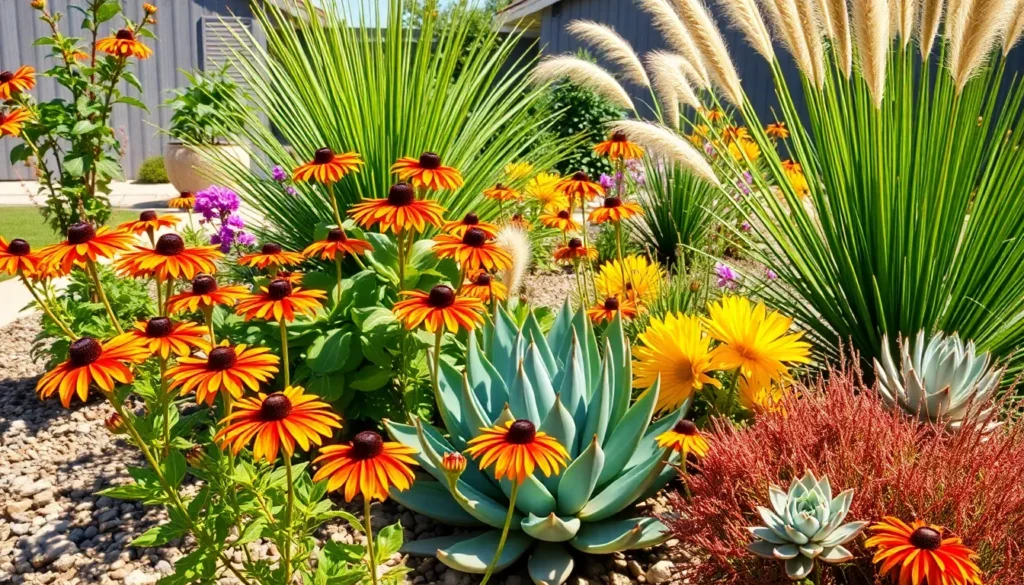We’ve all dreamed of having a stunning outdoor space that thrives without constant attention. Whether you’re a busy professional or simply prefer to spend weekends relaxing rather than gardening, low maintenance outdoor plants offer the perfect solution for creating beautiful landscapes with minimal effort.
The best part about choosing low-maintenance varieties is that they’re designed by nature to survive and flourish with little intervention. These hardy plants can withstand weather fluctuations, require infrequent watering, and still deliver impressive visual impact throughout the seasons. From drought-tolerant succulents to resilient native species, there’s an abundance of options that’ll transform your outdoor space without demanding your constant care.
We’re excited to share our carefully curated list of the most reliable low-maintenance outdoor plants that’ll help you create the garden of your dreams. These selections will save you time, reduce your water bills, and still provide the lush, vibrant outdoor environment you’ve been wanting.
Choose Drought-Tolerant Succulents for Effortless Outdoor Beauty
Succulents top our list of low maintenance outdoor plants because they’ve evolved to store water in their thick, fleshy leaves and stems. These remarkable plants can survive weeks without watering and actually prefer neglect over constant attention.
Aloe Vera: The Ultimate Healing Plant
Aloe vera combines medicinal benefits with stunning visual appeal in outdoor gardens across most climate zones. This spiky succulent produces thick, gel-filled leaves that can treat minor burns and cuts while requiring water only every 2-3 weeks during growing season.
Growing conditions for aloe vera couldn’t be simpler – we recommend planting it in well-draining soil with full to partial sun exposure. The plant reaches 12-24 inches in height and spreads up to 24 inches wide, making it perfect for border plantings or container gardens.
Winter care involves bringing potted aloe indoors in zones below 9, though established plants can tolerate brief cold snaps down to 25°F. We’ve found that overwatering kills more aloe plants than drought conditions ever will.
Sedum Varieties: Colorful Ground Cover Options
Sedum offers dozens of varieties that create stunning ground cover with minimal water requirements and maximum visual impact. Popular options include Autumn Joy, Dragon’s Blood, and Angelina sedum, each providing unique colors and textures throughout the growing season.
Popular Sedum Varieties for Outdoor Gardens:
| Variety | Height | Flower Color | Foliage Color | Bloom Time |
|---|---|---|---|---|
| Autumn Joy | 18-24 inches | Pink to rust | Green to burgundy | Late summer |
| Dragon’s Blood | 2-4 inches | Red | Green to red | Summer |
| Angelina | 3-6 inches | Yellow | Golden yellow | Early summer |
| Coral Carpet | 2-3 inches | Pink | Green | Summer |
Planting sedum requires nothing more than well-draining soil and occasional watering during extended dry periods. These hardy perennials spread naturally to fill gaps between rocks, along walkways, or in difficult slope areas where other plants struggle.
We love how sedum attracts butterflies and bees while deterring deer and rabbits from garden spaces. Most varieties remain evergreen in warmer climates and require division only every 3-4 years to maintain vigor.
Echeveria: Rosette-Shaped Desert Gems
Echeveria creates stunning architectural focal points with their perfect rosette formations and subtle color variations ranging from blue-green to deep purple. These Mexican natives thrive in outdoor containers or rock gardens where their geometric beauty can be fully appreciated.
Care requirements include bright sunlight for at least 6 hours daily and watering only when soil feels completely dry to the touch. We water our echeveria plants deeply but infrequently, allowing excess water to drain completely to prevent root rot.
Temperature tolerance varies by species, but most echeveria varieties handle temperatures down to 20°F when kept dry during winter months. Popular outdoor varieties include Echeveria elegans, Echeveria agavoides, and Echeveria purpusorum for their exceptional cold hardiness.
Propagation happens naturally through offsets that develop around the mother plant, giving us free new plants each growing season. We simply twist off mature offsets and plant them in sandy, well-draining soil for instant garden expansion.
Select Hardy Perennials That Return Year After Year
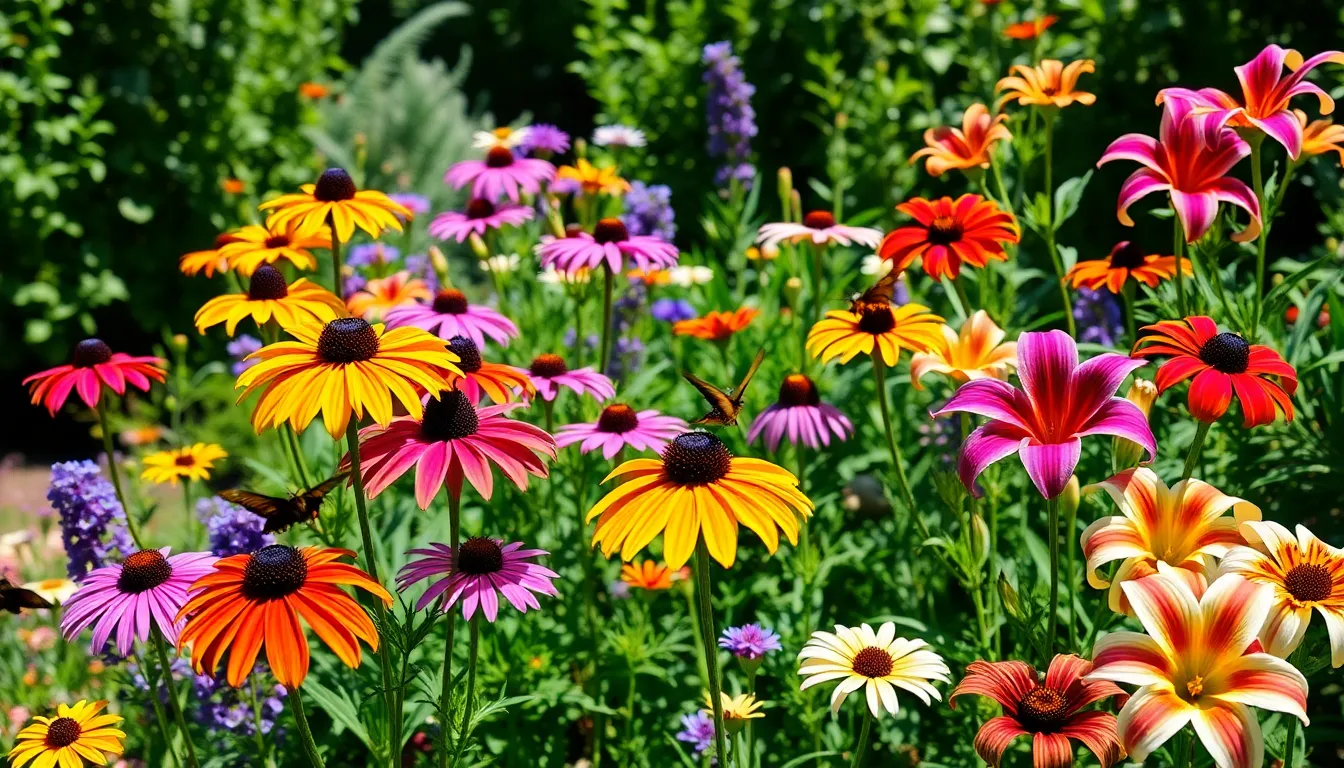
Hardy perennials offer the ultimate solution for gardeners seeking plants that deliver consistent beauty without annual replanting. These resilient plants establish strong root systems that survive winter conditions and emerge stronger each growing season.
Black-Eyed Susan: Bright Yellow Blooms
Black-Eyed Susan (Rudbeckia) stands out as one of our top recommendations for effortless outdoor gardening. Bright yellow flowers create stunning focal points that illuminate garden spaces from summer through fall. This resilient perennial adapts to a broad range of soil types without requiring special amendments or frequent fertilization.
We love how Black-Eyed Susan attracts beneficial pollinators like bees and butterflies while demanding minimal care from gardeners. Drought tolerance makes this plant perfect for regions with inconsistent rainfall patterns. Once established, it spreads naturally to fill empty garden spaces with vibrant color year after year.
Purple Coneflower: Pollinator-Friendly Flowers
Purple Coneflower (Echinacea) delivers striking purple flowers that serve as magnets for essential garden pollinators. Bees and butterflies flock to these blooms throughout the extended flowering period from summer into fall. This hardy perennial requires minimal watering and fertilization once its root system becomes established.
We appreciate how Purple Coneflower maintains its attractive appearance with very little intervention from gardeners. Seed heads left standing through winter provide food for birds while adding structural interest to dormant garden beds. Native plant enthusiasts particularly value this species for supporting local wildlife ecosystems.
Daylilies: Vibrant Colors with Minimal Care
Daylilies (Hemerocallis) offer an extensive variety of cultivars in colors ranging from pale yellow to deep burgundy. These versatile perennials possess strong drought tolerance that allows them to thrive in diverse soil conditions without constant moisture. Colorful flowers emerge reliably each season even though minimal maintenance requirements.
We recommend Daylilies for gardeners who want maximum visual impact with minimum effort investment. Occasional removal of spent blooms represents the only regular maintenance these plants require. Their clumping growth habit fills garden spaces efficiently while preventing weed establishment in surrounding areas.
Plant Native Species for Natural Adaptation
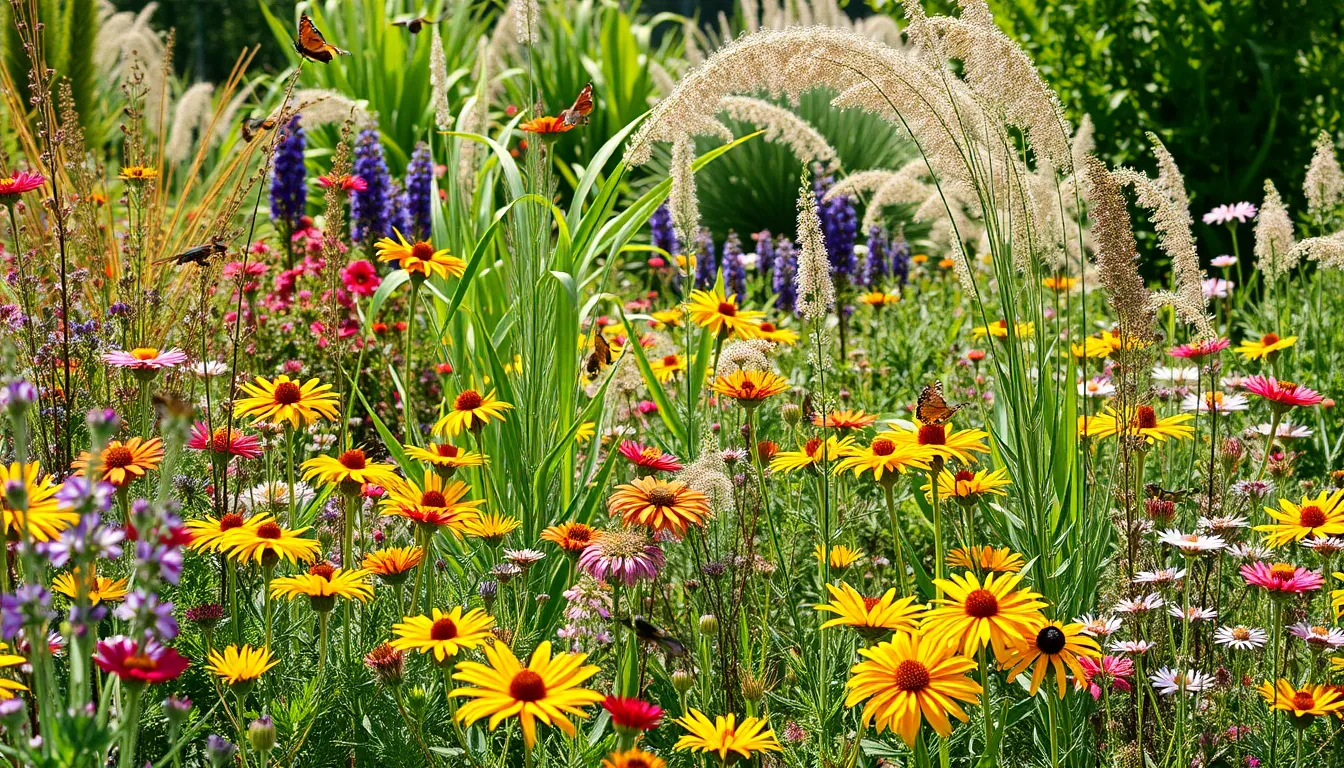
Native plants offer the ultimate solution for effortless outdoor gardening since they’ve naturally evolved to thrive in your local environment. We recommend choosing species that are indigenous to your area because they require significantly less water, fertilizer, and pest control than non-native alternatives.
Regional Wildflowers: Self-Sustaining Beauty
Regional wildflowers create stunning displays of color while supporting local ecosystems with minimal effort from us. These hardy blooms attract essential pollinators like bees and butterflies, transforming our gardens into vibrant wildlife habitats. Once established, wildflowers need little to no supplemental watering since they’re perfectly adapted to local rainfall patterns. Their natural growth cycles ensure seasonal interest throughout the year without requiring deadheading or constant maintenance from our end.
Native Grasses: Texture and Movement
Native grasses like switch grass bring ever-changing movement and interesting textures to our outdoor spaces while demanding virtually no care. These drought tolerant plants withstand various soil conditions and rarely need fertilization once they’re established in the ground. Their natural growth patterns eliminate the need for frequent trimming, saving us countless hours of maintenance work. We particularly appreciate how these grasses provide year round structure and create beautiful seed heads that feed birds during winter months.
Indigenous Shrubs: Structure and Privacy
Indigenous shrubs such as Virginia Sweetspire and Ninebark provide essential structure and natural privacy screens with remarkable durability. Buttonbush thrives in both moist areas and regular garden soils, making it incredibly versatile for different industry needs. These native shrubs offer seasonal interest through attractive flowers, colorful foliage, or distinctive bark textures without requiring intensive pruning or care. We value how they create shelter for local wildlife while establishing strong root systems that prevent soil erosion naturally.
Install Ornamental Grasses for Year-Round Interest
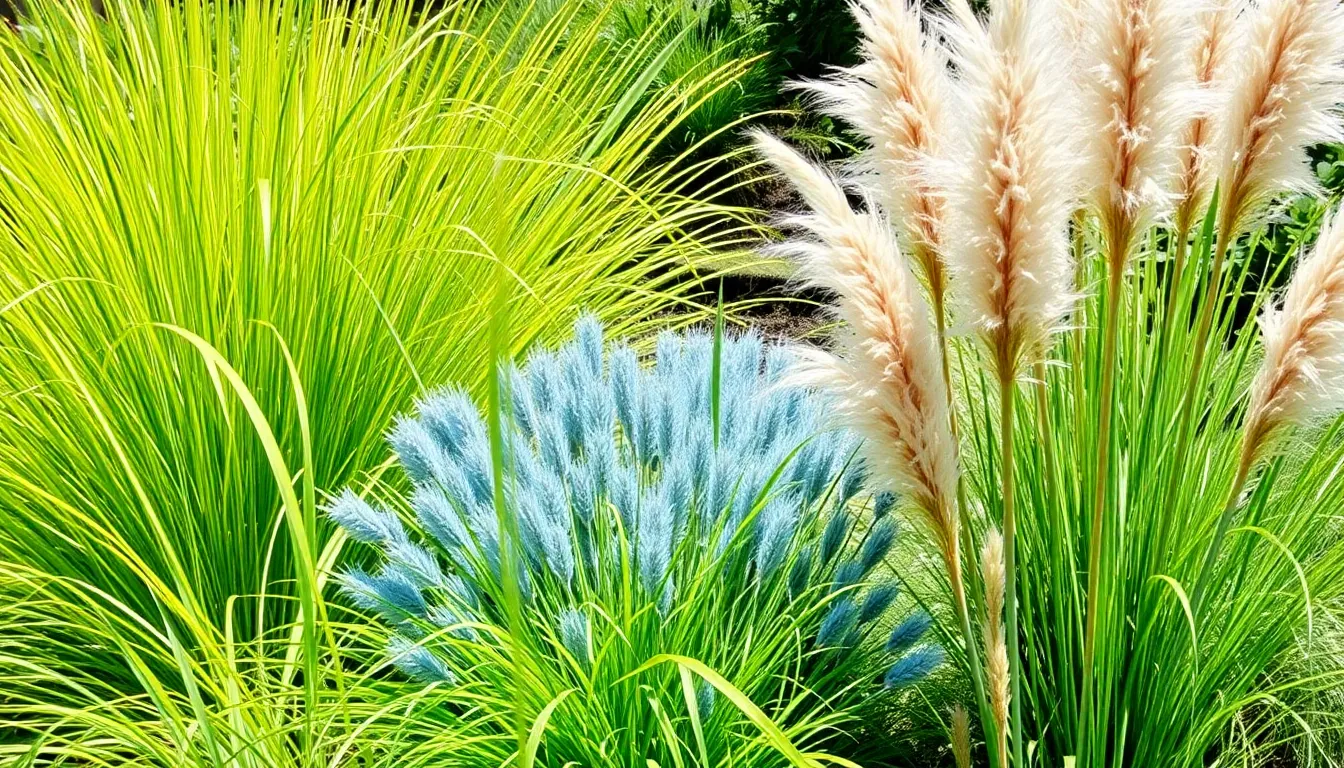
Ornamental grasses offer exceptional value in outdoor gardens because they maintain visual appeal throughout all seasons while requiring minimal maintenance. We recommend incorporating these hardy grass varieties that provide texture, movement, and structural interest with virtually no upkeep.
Fountain Grass: Graceful Arching Blades
Fountain Grass creates stunning focal points with its naturally arching blades that form elegant rounded clumps. This resilient grass produces feathery plumes from late summer through fall, adding soft texture and gentle movement to any industry. We’ve found it thrives in various soil conditions and requires only occasional watering once established.
Growth specifications: Typically reaches 2-4 feet in height and spreads 2-3 feet wide, making it perfect for borders or mass plantings. The distinctive plumes persist well into winter, providing continued interest when other plants go dormant. Drought tolerance makes this grass ideal for water-wise gardening approaches.
Blue Fescue: Compact Silver-Blue Tufts
Blue Fescue stands out with its striking silver-blue coloration that creates beautiful contrast in garden beds. These compact ornamental grasses form dense, mounding habits that work exceptionally well in rock gardens and border applications. We appreciate how this variety maintains its attractive appearance year-round without any special care requirements.
Maintenance benefits: Thrives in well-drained soil and actually prefers poor growing conditions over rich, fertile ground. Small size makes it perfect for container gardening or tight spaces where larger grasses won’t fit. Established clumps can handle extended drought periods without supplemental watering.
Pampas Grass: Dramatic Height and Plumes
Pampas Grass provides impressive vertical interest with its towering height and spectacular feathery flower heads. This commanding grass creates natural focal points that draw attention across large outdoor spaces. We recommend using it as a backdrop plant or privacy screen due to its substantial size and year-round presence.
Seasonal performance: Showy plumes appear in late summer and persist through winter months, offering multi-season appeal. Mature plants can reach 6-10 feet tall with equally impressive spread, making them suitable for larger landscapes. Even though their dramatic appearance, these grasses require minimal water and virtually no fertilization once established.
Incorporate Evergreen Shrubs for Consistent Structure
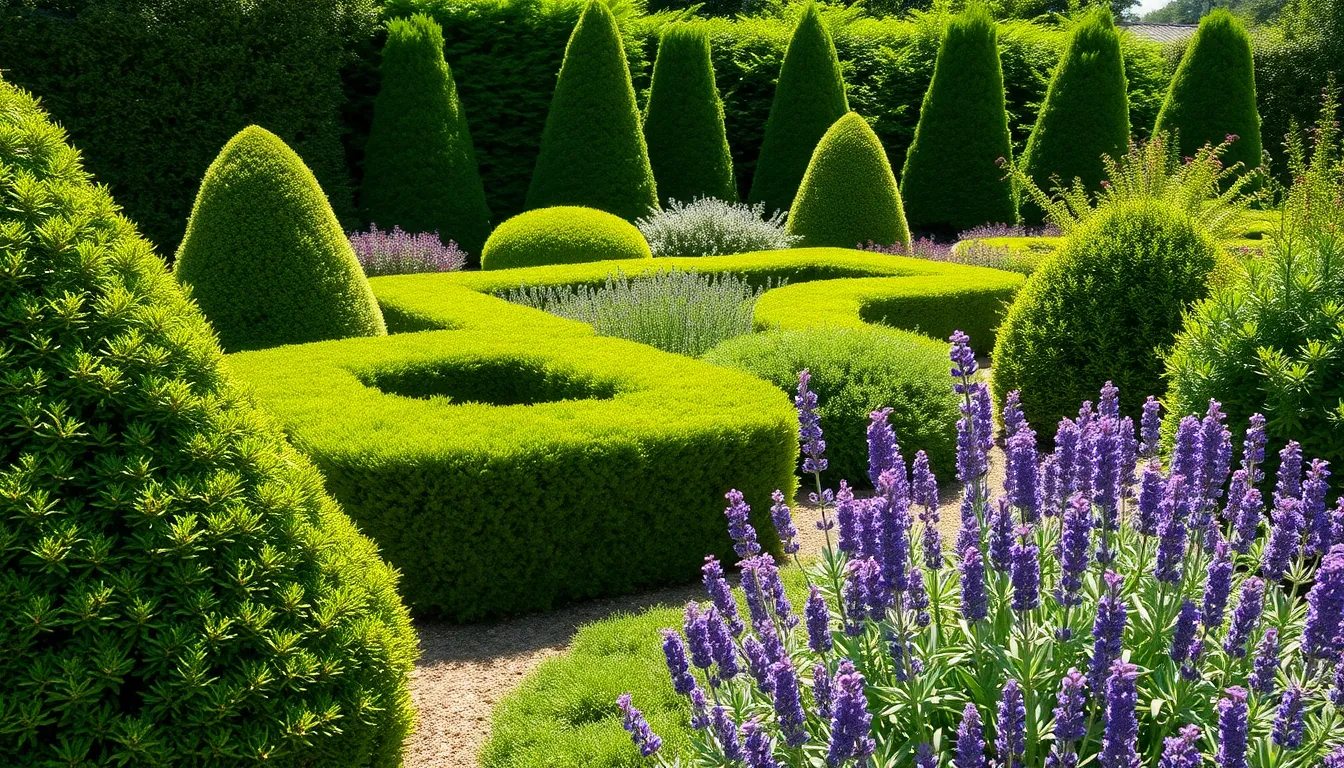
Evergreen shrubs serve as the backbone of low maintenance outdoor gardens, providing year-round structure and visual interest. These hardy plants maintain their foliage through all seasons, ensuring our gardens look polished even during winter months.
Boxwood: Classic Hedge Material
Boxwood stands out as the quintessential choice for creating formal hedges and structured garden borders. Dense, small, glossy green leaves give this versatile shrub its distinctive appearance that complements any industry design. We appreciate boxwood’s remarkable adaptability, as it thrives whether shaped into precise formal hedges or left to grow naturally for a more relaxed garden aesthetic.
Drought tolerance makes boxwood an excellent low maintenance option once it’s established in our gardens. Minimal pruning keeps these shrubs looking their best, requiring only occasional trimming to maintain their desired shape. Their evergreen nature ensures our outdoor spaces retain visual structure throughout winter when other plants go dormant.
Juniper: Versatile Shapes and Sizes
Junipers offer incredible diversity in form, ranging from sprawling groundcovers to upright small trees that fit various garden designs. Full sun exposure brings out the best in these resilient plants, while they tolerate poor soil conditions that challenge other shrubs. Their needle-like foliage displays beautiful color variations from blue-green to silver, adding textural contrast to our outdoor plantings.
Low water requirements make junipers ideal for drought-prone areas and busy gardeners alike. Pest and disease resistance further reduces maintenance needs, allowing us to enjoy their beauty without constant intervention. These hardy shrubs provide reliable structure and color with minimal care requirements throughout the growing season.
Lavender: Fragrant Purple Spikes
Lavender combines visual appeal with delightful fragrance, creating a sensory experience in our low maintenance gardens. Purple flower spikes attract beneficial pollinators like bees while releasing their signature aromatic oils into the surrounding air. Well-drained soil and full sun exposure create the perfect conditions for lavender to flourish with minimal intervention.
Established lavender plants require very little supplemental watering, making them perfect for water-conscious gardening. Annual light pruning maintains their compact shape and encourages fresh growth for the following season. Beyond their aesthetic value, these aromatic plants contribute to the overall sensory appeal of our outdoor spaces while demanding virtually no ongoing care.
Add Ground Cover Plants to Suppress Weeds
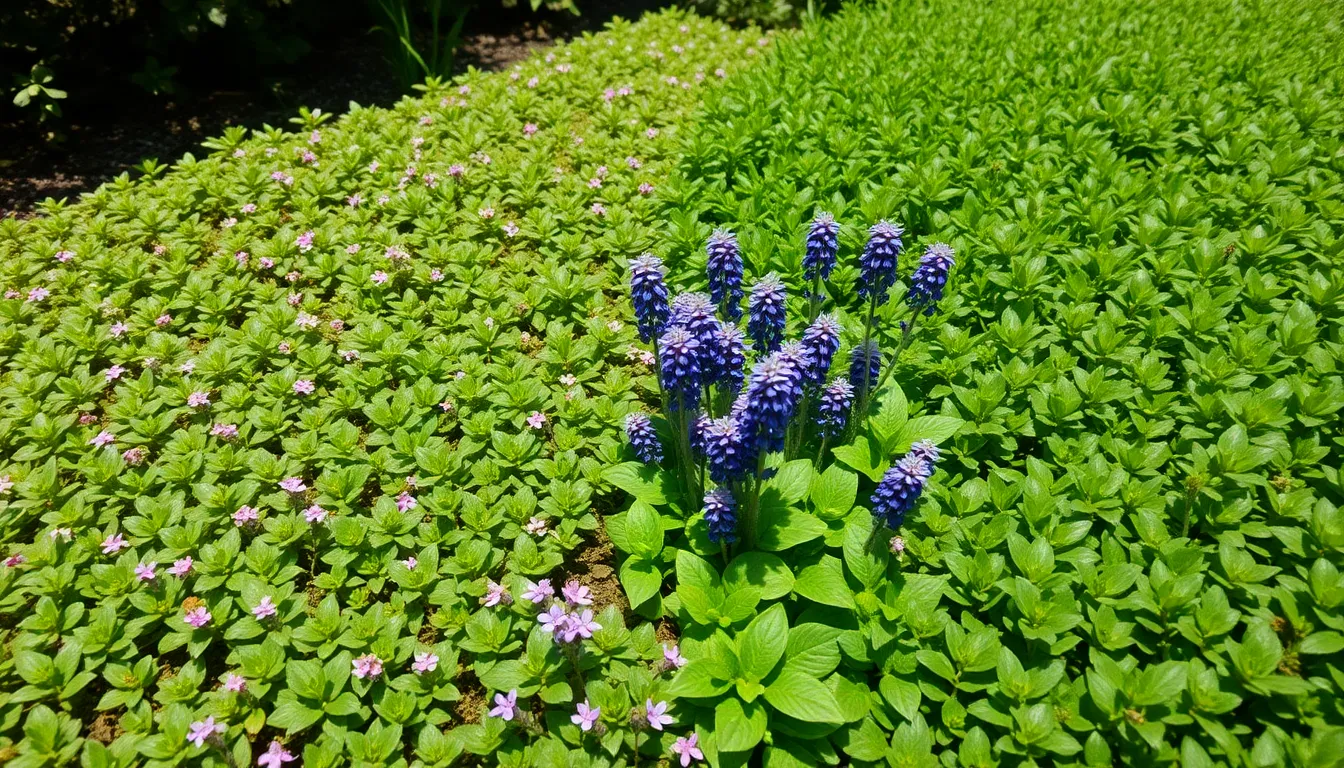
Ground cover plants create natural weed barriers while reducing maintenance needs in your outdoor spaces. We’ve selected three outstanding options that’ll transform bare soil into beautiful, functional landscapes.
Creeping Thyme: Aromatic Carpet
Creeping Thyme forms a dense mat of tiny leaves that releases delightful fragrance when walked upon. This aromatic perennial herb produces purple or pink flowers during summer months, creating stunning visual displays alongside its practical benefits.
Full sun locations with well-drained soil provide ideal growing conditions for this hardy ground cover. Drought tolerance makes it perfect for water-wise gardening, requiring minimal irrigation once established in your industry.
Dense growth patterns effectively crowd out competing weeds while withstanding light foot traffic. We recommend using Creeping Thyme along walkways or in garden beds where its aromatic qualities can be appreciated daily.
Ajuga: Colorful Foliage Spreader
Ajuga spreads quickly through underground runners, creating vibrant carpets of glossy foliage in record time. Also known as bugleweed, this fast-growing ground cover displays leaves ranging from green to deep purple, often featuring attractive variegation patterns.
Spring brings spectacular spikes of blue flowers that complement the colorful foliage display. Versatile growing conditions from partial shade to full sun make Ajuga adaptable to various garden locations and soil types.
Thick foliage smothers emerging weeds while providing year-round textural interest in your industry. We appreciate how this colorful spreader fills empty spaces quickly without requiring constant attention or care.
Pachysandra: Dense Shade Solution
Pachysandra thrives in shady areas where traditional grass lawns struggle to survive. This evergreen perennial creates thick carpets through slow underground spreading, forming dense coverage that effectively blocks weed growth.
Glossy green leaves maintain their attractive appearance throughout all seasons, providing consistent visual appeal. Minimal watering requirements after establishment make this shade-loving ground cover incredibly low maintenance for busy gardeners.
Moist, well-drained soil conditions support optimal growth in areas receiving limited sunlight. We find Pachysandra particularly valuable for transforming challenging shaded spots into attractive, weed-free garden areas that require virtually no ongoing maintenance.
Establish Bulbs for Seasonal Color Bursts
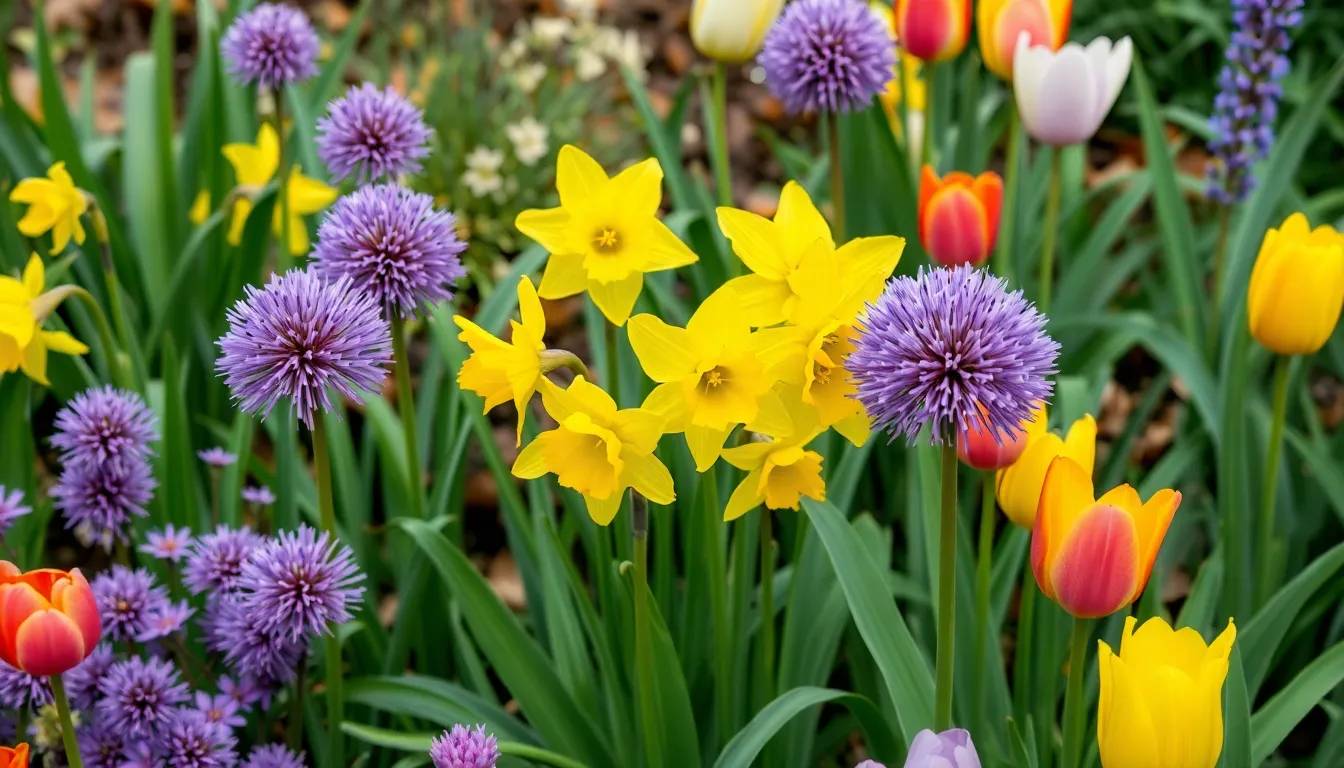
Bulbs offer an exceptional way to create stunning seasonal displays with minimal ongoing maintenance. We can plant these hardy gems once and enjoy years of reliable blooms that emerge naturally each season.
Daffodils: Early Spring Sunshine
Daffodils deliver the easiest path to early spring color in our low maintenance gardens. These carefree bulbs resist deer and rodents while naturalizing to return stronger each year, providing 4-6 weeks of continuous blooms when we select early, mid, and late varieties.
Plant daffodil bulbs 3-6 inches deep and space them 4-6 inches apart in well-drained soil during fall between late September and early November. Full to partial sunlight works perfectly, and they thrive in slightly acidic to neutral soil with a pH of 6.0-7.0.
Water thoroughly after planting and add mulch to retain moisture through winter. Once established, daffodils require virtually no ongoing care, making them ideal for busy gardeners who want reliable spring sunshine in their outdoor spaces.
Alliums: Architectural Purple Spheres
Alliums bridge the seasonal gap between spring bulbs and summer perennials with their dramatic spherical purple flowers. These architectural beauties bloom in late spring into early summer, adding striking vertical interest to our low maintenance plantings.
Plant allium bulbs 6-8 inches deep with 4-5 inches of spacing in full sun locations. Their tall stems and unique flower heads create long-lasting color without frequent watering or intensive care once established.
Bees and butterflies flock to allium blooms, making them excellent pollinator-friendly additions to our gardens. These bulbs require minimal maintenance while delivering maximum visual impact through their distinctive purple spheres.
Tulips: Classic Spring Favorites
Tulips provide classic spring beauty that complements our daffodil displays perfectly. Plant tulip bulbs 6-8 inches deep and 4-6 inches apart with pointed ends facing up in well-drained soil enriched with organic matter.
Deep watering once weekly during growth keeps soil moist but not soggy, which prevents bulb rot. Full to partial sun exposure works best, and a 2-3 inch mulch layer after planting retains moisture while insulating against cold temperatures.
Allow tulip foliage to die back naturally after flowering to replenish bulb energy for next year’s blooms. In wet climates, we may need to lift and store bulbs in cool, dry places to prevent rot and ensure continued flowering success.
Consider Container Plants for Flexible Placement
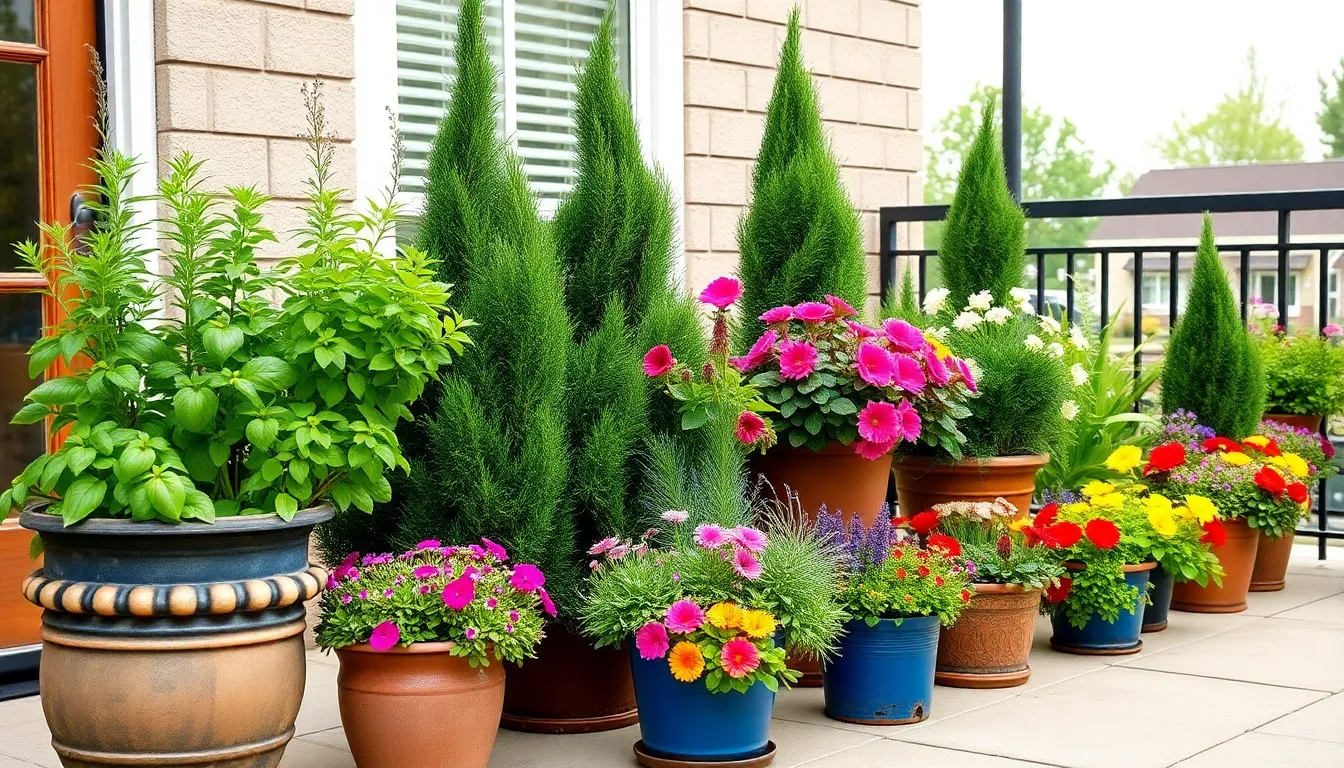
Container gardening transforms outdoor spaces by offering unmatched flexibility in plant placement and care. We can easily relocate containers to optimize sunlight exposure or adapt to seasonal changes without the commitment of permanent planting.
Potted Herbs: Culinary and Aromatic Benefits
Potted herbs deliver dual benefits as low maintenance outdoor plants that enhance both our gardens and kitchens. Sage, rosemary, thyme, and basil thrive in containers with minimal care while providing fresh ingredients for cooking throughout the growing season. These aromatic plants prefer well-drained soil and partial sun but tolerate neglect better than most garden varieties.
Growing herbs in containers allows us to position them near outdoor cooking areas for convenient harvesting. We’ll find that their continuous growth provides steady supplies of fresh flavors while their fragrant foliage adds sensory appeal to patios and decks. Most culinary herbs actually perform better with occasional neglect rather than constant attention.
Dwarf Conifers: Year-Round Green Structure
Dwarf conifers serve as compact evergreens that provide consistent structure and color throughout all seasons. These hardy specimens require minimal pruning and become drought tolerant once established in their containers. We can use them as foundation plants around seating areas or as focal points in container displays.
Their slow growth rate significantly reduces our maintenance workload compared to other shrubs and trees. Metal or durable planters enhance their visual appeal while supporting their long term health and development. Dwarf varieties maintain their attractive shape naturally without frequent intervention from us.
Seasonal Annuals: Rotating Color Displays
Seasonal annuals bring ever-changing color changes to our outdoor spaces without requiring long term maintenance commitments. We can select low maintenance varieties that complete their entire lifecycle in one season while providing maximum visual impact. Changing annuals seasonally allows us to refresh color schemes effortlessly throughout the year.
Container grown annuals offer flexibility to experiment with different combinations and arrangements. We’ll discover that choosing easy growth varieties with minimal feeding requirements keeps our workload light while maintaining vibrant displays. This rotating approach lets us adapt our outdoor aesthetics with little effort while keeping maintenance demands low.
Conclusion
We’ve explored an extensive range of low-maintenance outdoor plants that’ll transform your garden into a stunning industry without demanding countless hours of care. From drought-tolerant succulents to hardy perennials native grasses and versatile container options there’s truly something for every outdoor space and gardening preference.
The beauty of these resilient plants lies in their ability to thrive independently while still delivering the visual impact we all crave in our gardens. Whether you’re dealing with challenging soil conditions limited time or simply want to enjoy your outdoor space more than maintain it these plant selections offer the perfect solution.
Your journey to a beautiful low-maintenance garden starts with choosing the right plants for your exact conditions and letting nature do most of the work. We’re confident that with these recommendations you’ll create an outdoor sanctuary that brings joy year after year with minimal effort required.
Frequently Asked Questions
What makes a plant low-maintenance for outdoor gardens?
Low-maintenance plants are naturally hardy and require minimal intervention to thrive. They typically need infrequent watering, little to no fertilizing, minimal pruning, and can adapt to various soil conditions. These plants have evolved to withstand environmental challenges like drought, poor soil, and temperature fluctuations, making them perfect for busy gardeners or those who prefer effortless outdoor beauty.
Which succulents are best for low-maintenance outdoor gardens?
The top drought-tolerant succulents include Aloe Vera, which offers medicinal benefits and requires minimal watering in well-draining soil. Sedum varieties provide colorful ground cover while attracting beneficial wildlife and deterring pests. Echeveria stands out for its striking rosette shapes and thrives in bright sunlight with dry conditions, making all three excellent choices for effortless outdoor beauty.
What are the benefits of choosing native plants for my garden?
Native plants have evolved to thrive in local environments, requiring significantly less water, fertilizer, and pest control than non-native species. They support local ecosystems by providing food and habitat for wildlife, including pollinators. Regional wildflowers, native grasses, and indigenous shrubs offer stunning displays while needing minimal supplemental care, creating sustainable and environmentally-friendly gardens.
How do ornamental grasses contribute to low-maintenance landscaping?
Ornamental grasses provide year-round visual interest with minimal upkeep requirements. Fountain Grass offers graceful arching blades and feathery plumes, Blue Fescue provides compact silver-blue tufts ideal for small spaces, and Pampas Grass creates dramatic height for larger landscapes. Once established, these grasses require minimal water and fertilization while adding texture and movement to garden designs.
What ground cover plants help reduce garden maintenance?
Effective ground cover plants include Creeping Thyme, which thrives in full sun with minimal irrigation and works well for walkways. Ajuga offers colorful foliage and rapid growth to smother weeds in various light conditions. Pachysandra excels in shaded areas, requiring minimal watering while creating dense, weed-free coverage that transforms challenging garden spots into attractive spaces.
Are container gardens suitable for low-maintenance outdoor spaces?
Yes, container gardening offers excellent flexibility for low-maintenance outdoor spaces. Potted herbs like sage, rosemary, thyme, and basil provide fresh culinary ingredients with minimal care. Dwarf conifers offer year-round structure, while seasonal annuals provide rotating color displays. Containers allow easy plant relocation to optimize sunlight and adapt to seasonal changes without permanent landscape commitments.
Which perennials require the least maintenance but provide the most impact?
Hardy perennials like Black-Eyed Susan offer bright yellow blooms and adapt to various soil types while attracting pollinators. Purple Coneflower provides striking purple flowers that attract beneficial insects and require minimal watering. Daylilies deliver vibrant colors with strong drought tolerance and need only occasional maintenance, making all three excellent choices for maximum impact with minimal effort.
How do evergreen shrubs contribute to low-maintenance garden structure?
Evergreen shrubs provide consistent year-round structure with minimal care requirements. Boxwood adapts well to various conditions and tolerates drought, perfect for hedges with minimal pruning. Junipers offer versatile forms with low water needs and pest resistance. Lavender provides fragrant purple flowers that attract pollinators while requiring minimal care, creating both structure and sensory appeal in low-maintenance gardens.

